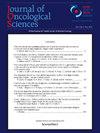Unresectable Hepatocellular Carcinoma and Prognostic Factors of Sorafenib Treatment: A Real-Life Experience
Q4 Medicine
引用次数: 0
Abstract
ABS TRACT Objective: Sorafenib is the first targeted therapy for patients with advanced hepatocellular carcinoma (HCC). This multicenter study primarily aimed to assess real-life experiences of sorafenib in patients with advanced HCC in Türkiye and to determine the prognostic factors. Material and Methods: Patients treated with sorafenib for HCC treatment were included in a retrospective collection of demographic, clinical, and laboratory data. Overall survival (OS) and progression-free survival (PFS), safety data, and prognostic factors were analyzed. Results: A total of 147 patients receiving sorafenib from six tertiary oncology centers were included. Approximately 88.4% and 11.6% of patients were Child-Pugh (CP) classes A and B, respectively. The median PFS was 5.1 (95% CI, 4.3 to 5.9) and 2.9 months (95% CI, 2.3 to 3.5), and OS was 9.8 (95% CI, 6.4 to 13.2) and 5.3 months (95% CI, 4.1 to 6.5) in patients with CP-A and CP-B, respectively. There was a difference in OS between CP-A and B (p=<0.001). The most common adverse event was diarrhea (19.7%, Grade 1-2; 6.8%, Grade 3). The eastern cooperative oncology group (ECOG) performance score, CP score, neutrophil-lymphocyte ratio (NLR), and alpha-fetoprotein (AFP) values were found to be independent prognostic factors. Conclusion: OS and PFS were similar in routine clinical practice compared to Phase III pivotal SHARP and Asia-Pacific trials. The median survival was longer in those with a better ECOG performance score, CP-A, and lower NLR and AFP levels.不可切除的肝细胞癌和索拉非尼治疗的预后因素:一个真实的经验
目的:索拉非尼是晚期肝细胞癌(HCC)患者的首个靶向治疗药物。这项多中心研究主要旨在评估 rkiye晚期HCC患者使用索拉非尼的真实经历,并确定预后因素。材料和方法:使用索拉非尼治疗HCC的患者纳入回顾性收集人口统计学、临床和实验室数据。分析了总生存期(OS)和无进展生存期(PFS)、安全性数据和预后因素。结果:共纳入来自6个三级肿瘤中心的147例接受索拉非尼治疗的患者。约88.4%和11.6%的患者分别为Child-Pugh (CP) A级和B级。CP-A和CP-B患者的中位PFS分别为5.1 (95% CI, 4.3至5.9)和2.9个月(95% CI, 2.3至3.5),OS分别为9.8 (95% CI, 6.4至13.2)和5.3个月(95% CI, 4.1至6.5)。CP-A与B的OS差异有统计学意义(p=<0.001)。最常见的不良事件是腹泻(19.7%,1-2级;东部肿瘤合作组(ECOG)表现评分、CP评分、中性粒细胞-淋巴细胞比率(NLR)和甲胎蛋白(AFP)值是独立的预后因素。结论:与III期关键性SHARP和亚太试验相比,OS和PFS在常规临床实践中相似。ECOG表现评分、CP-A、NLR和AFP水平较低的患者中位生存期较长。
本文章由计算机程序翻译,如有差异,请以英文原文为准。
求助全文
约1分钟内获得全文
求助全文
来源期刊

Journal of Oncological Sciences
Medicine-Oncology
CiteScore
0.10
自引率
0.00%
发文量
16
审稿时长
29 weeks
 求助内容:
求助内容: 应助结果提醒方式:
应助结果提醒方式:


